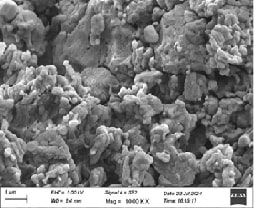Nanoparticle-Driven Healing: Evaluating Chitosan-Copper in Zebrafish Wound Recovery

Abstract:
Wound healing poses a critical clinical challenge, especially in chronic wounds where conventional treatments often fail. This study investigates the wound healing potential of β-Chitosan-copper oxide nanoparticles (β-Ch-CuO-NPs) at 10 μg/mL and 20 μg/mL using a zebrafish (Danio rerio) model. Zebrafish, renowned for their regenerative ability and transparent tissues, facilitated real-time observation of healing. The β-Ch-CuO-NP-treated groups exhibited enhanced wound closure, with the 20 μg/mL concentration outperforming the 10 μg/mL and control groups. These findings highlight that β-Ch-CuO-NPs can be used as a therapeutic remedy for wound healing, encouraging further translational and clinical research. To evaluate the wound healing efficacy of β-Chitosan-copper oxide nanoparticles (β-Ch-CuO-NPs) in zebrafish (Danio rerio). Chronic wounds pose a significant clinical challenge due to delayed healing and persistent inflammation. β-Ch-CuO-NPs have emerged as promising agents as they are much more biocompatible with properties such as antimicrobicity and the ability to modulate tissue repair mechanisms. Zebrafish were divided into control and treated groups receiving β-Ch-CuO-NPs at 10 μg/mL and 20 μg/mL. Wound healing was assessed through histological and molecular analyses over 14 days. The successful synthesis of β-Ch-CuO-NPs was confirmed by the characterization studies done, revealing a crystalline structure corresponding to copper oxide. Microscopic analysis of the zebrafish model revealed that the nanoparticles lead to a significant amount of wound closure when compared to the control. The 20 μg/mL group demonstrated superior wound closure, faster re-epithelialization, increased fibroblast proliferation, collagen deposition and reduced inflammation compared to other groups. β-Ch-CuO-NPs effectively promote wound healing by enhancing and accelerating wound closure, and tissue regeneration, indicating potential for clinical applications.
References:
[1]. Ali,
S., Zulfiqar, M., Summer, M., Arshad, M., Noor, S., Nazakat, L., & Javed,
A., 2024. Zebrafish as an innovative model for exploring cardiovascular disease
induction mechanisms and novel therapeutic interventions: a molecular
insight. Molecular Biology Reports, 51(1), 904.
[2]. Anbarasu,
M., Martin, T. M., Priya, P., Sivamurugan, V., Kumar, M. S. K., Shaik, M. R., .
& Guru, A., 2024. Assessing the impact of Ag-ZnO nanoparticle on the
induction of oxidative stress, hematological, and molecular changes in
zebrafish (Danio rerio) and McCoy fibroblast cell lines. Aquaculture
International, 32(4), 5373-5392.
[3]. Anbarasu,
M., Vinitha, V., Priya, P., Martin, T. M., Prathap, L., Kumar, M. S. K., .
& Sivamurugan, V., 2024. Depolymerization of PET Wastes Catalysed by Tin and
Silver doped Zinc oxide Nanoparticles and Evaluation of Embryonic Toxicity
Using Zebrafish. Water, Air, & Soil Pollution, 235(6), 433.
[4]. Banaee,
M., & Badr, A. A., 2024. Bioinformatic evaluation of the impact of miRNAs
on the expression of detoxification-related genes in Zebrafish (Danio
rerio). Journal of Aquatic Ecology, 14(1), 1-12.
[5]. Pawar,
N. V., Singh, P. D., Prabhu, P. S., & Rana, J. R., 2021. Carcinogen‐Induced
Model of Proangiogenesis in Zebrafish Embryo‐Larvae. Environmental
Toxicology and Chemistry, 40(2), 447-453.
[6]. Dandagi,
P., & Martin, T. M., 2024. In Silico and Glioblastoma Cell Line Evaluation of
Thioflavin-Derived Zinc Nanoparticles Targeting Beclin Protein. Cureus, 16(9),
e69319.
[7]. Qian,
L., Cui, F., Yang, Y., Liu, Y., Qi, S., & Wang, C., 2018. Mechanisms of
developmental toxicity in zebrafish embryos (Danio rerio) induced by
boscalid. Science of the Total Environment, 634, 478-487.
[8]. Ramachandran,
T., Mohanraj, K. G., & Martin, T. M., 2024. Enhanced Wound
Healing With β-Chitosan-Zinc Oxide Nanoparticles: Insights From Zebrafish
Models. Cureus, 16(9), e69861.
[9]. Rajasekar,
N., Mohanraj, K. G., & Martin, T. M., 2024. Advanced Dental Care:
β-Chitosan Zinc Oxide Nanoparticles Targeting Cariogenic Microorganisms. Cureus, 16(8),
e66296.
[10]. Umakanth,
K., & Martin, T. M., 2024. An In Vitro and In Silico Study of
Luteolin-Loaded Zinc Oxide Nanoparticles: Enhancing Bioactivity and Efficacy
for Advanced Therapeutic Applications Against Cariogenic Microorganisms. Cureus, 16(8),
e68058.
[11]. Umapathy,
S., Pan, I., Issac, P. K., Kumar, M. S. K., Giri, J., Guru, A., &
Arockiaraj, J., 2024. Selenium Nanoparticles as Neuroprotective Agents:
Insights into Molecular Mechanisms for Parkinson’s Disease Treatment. Molecular
Neurobiology, 1-28.
[12]. Raj,
P. S. M., Martin, T. M., Kumar, M. S. K., & Prathap, L., 2024.
Anti-psychotic Nature of Antibiotics: Vancomycin and Omadacycline Combination
Ameliorating Stress in a Zebrafish Model. Cureus, 16(3).
[13]. Tayyeb,
J. Z., Priya, M., Guru, A., Kishore Kumar, M. S., Giri, J., Garg, A., . &
Arockiaraj, J., 2024. Multifunctional curcumin mediated zinc oxide nanoparticle
enhancing biofilm inhibition and targeting apoptotic specific pathway in oral
squamous carcinoma cells. Molecular Biology Reports, 51(1), 423.
[14]. Atalar,
M. N., Köktürk, M., Altındağ, F., Ozhan, G., Özen, T., Demirtas, İ., &
Gülçin, İ., 2023. LC-ESI-MS/MS analysis of secondary metabolites of different
St. John's wort (Hypericum perforatum) extracts used as food supplements and
evaluation of developmental toxicity on zebrafish (Danio rerio) embryos and
larvae. South African Journal of Botany, 159, 580-587.
[15]. Payra,
M., Mohanraj, K. G., & Martin, T. M., 2024. Modulation of Inflammation in
McCoy Cells by Zinc Nanoparticles Conjugated With
β-Chitosan. Cureus, 16(9), e68653.
[16]. Orger,
M. B., & de Polavieja, G. G., 2017. Zebrafish behavior: opportunities
and challenges. Annual review of neuroscience, 40(1), 125-147.
[17]. Pang,
S., Gao, Y., Wang, F., Wang, Y., Cao, M., Zhang, W., . & Jiang,
G., 2020. Toxicity of silver nanoparticles on wound healing: A case study of
zebrafish fin regeneration model. Science of the Total Environment, 717,
137178.
[18]. Sharif,
F., Steenbergen, P. J., Metz, J. R., & Champagne, D. L., 2015. Long‐lasting
effects of dexamethasone on immune cells and wound healing in the
zebrafish. Wound Repair and Regeneration, 23(6), 855-865.
[19]. Edirisinghe,
S. L., Nikapitiya, C., Kim, C. H., Castex, M., Leclercq, E., & De Zoysa, M.,
2023. Dietary supplementation with a multi-strain yeast
fraction enhances skin wound healing in zebrafish (Danio
rerio). Aquaculture Reports, 32, 101741.

